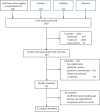Proton pump inhibitors are not associated with fundic gland polyps - a systematic review that takes into consideration all known confounders
- PMID: 38829941
- PMCID: PMC11146189
- DOI: 10.1097/MEG.0000000000002788
Proton pump inhibitors are not associated with fundic gland polyps - a systematic review that takes into consideration all known confounders
Abstract
Sporadic fundic gland polyps (FGPs) progress, albeit rarely, to dysplasia and cancer. Two meta-analyses, including 8 and 11 studies, concluded that proton pump inhibitors (PPIs) were associated with FGPs. Intervention is considered unnecessary when FGPs have a background of PPIs use. Both meta-analyses, however, disregarded known confounders: age, sex, endoscopy indications, study design (prospective or retrospective), duration of PPI use, and H. pylori infection. Confounders are known to invalidate meta-analyses. We followed PRIXMA guidelines and searched the literature for studies on FGPs in PPI-users and PPI-nonusers. In the 22 studies searched, we compared FGPs in PPI-users (n = 6534) and PPI-nonusers (n = 41 115). Heterogeneity was significant (Cochran Q = 277.8, P < 0.0001; I2 = 92.8%), annulling meta-analysis performed by blanket tallying. To offset the above confounders, we matched PPI-users and PPI-nonusers by (a) age and sex (n = 4300 and 29 307, respectively) and (b) their propensity scores derived from the confounders (n = 2950 and 4729, respectively). After both matching, FGPs were not significantly different between PPI-users and PPI-nonusers [odds ratio (OR) = 1.1, P = 0.3078; OR = 0.9, P = 0.3258, respectively]. Furthermore, FGP frequency did not correlate with increasing duration of PPI use (Pearson and Spearman correlation coefficients = 0.1162, 0.0386, P < 0.6064, 0.8646, respectively); it was not significantly different between any of the duration periods of observation, namely, <10, 10-20, 20-40, >40 months, nor was it significantly different between PPI-users and PPI-nonusers within each duration period (P > 0.05). We conclude that PPIs are not associated with FGPs, implying that a background history of PPI use is not a justification for nonintervention in the management of FGPs.
Copyright © 2024 The Author(s). Published by Wolters Kluwer Health, Inc.
Conflict of interest statement
There are no conflicts of interest.
Figures




Similar articles
-
Sporadic fundic gland polyps are not associated with proton pump inhibitors therapy but negatively correlate with Helicobacter pylori infection in China.Chin Med J (Engl). 2014;127(7):1239-43. Chin Med J (Engl). 2014. PMID: 24709173
-
Histological analysis of fundic gland polyps secondary to PPI therapy.Histopathology. 2019 Oct;75(4):537-545. doi: 10.1111/his.13902. Epub 2019 Aug 2. Histopathology. 2019. PMID: 31087669
-
Relative risk factors associated with the development of fundic gland polyps.Eur J Gastroenterol Hepatol. 2014 Nov;26(11):1217-21. doi: 10.1097/MEG.0000000000000199. Eur J Gastroenterol Hepatol. 2014. PMID: 25187299
-
Current Guidelines and Advances in the Management of Fundic Gland Polyps.J Gastroenterol Hepatol. 2025 Jun;40(6):1374-1380. doi: 10.1111/jgh.16972. Epub 2025 Apr 21. J Gastroenterol Hepatol. 2025. PMID: 40259438 Review.
-
Sporadic fundic gland polyps with dysplasia or carcinoma: Clinical and endoscopic characteristics.World J Gastrointest Oncol. 2021 Jul 15;13(7):662-672. doi: 10.4251/wjgo.v13.i7.662. World J Gastrointest Oncol. 2021. PMID: 34322195 Free PMC article. Review.
References
-
- Mazer-Amirshahi M, Mullins PM, van den Anker J, Meltzer A, Pines JM. Rising rates of proton pump inhibitor prescribing in US emergency departments. Am J Emerg Med 2014; 32:618–622. - PubMed
-
- National Health Service (NHS Digital). Prescription cost analysis - England, 2017 [PAS]. 2018. https://digital.nhs.uk/data-andinformation/publications/statistical/pres.... [Accessed 21 June 2018]
Publication types
MeSH terms
Substances
LinkOut - more resources
Full Text Sources

